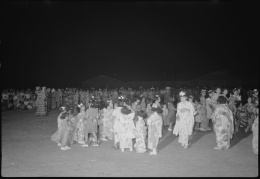Bon dance / ondo
Communal folk dances associated with the bon festival, a Buddhist summer ceremony in which the spirits of departed ancestors are welcomed back to the world of the living for their annual visit. A national custom in Japan by the Edo period, bon festivals became a big part of Japanese immigrant life in the continental United States and Hawai'i before World War II. Bon dances are a series of communal dances performed by men, women, and children alike while moving in a circle around musicians—or sometimes recorded music—on a central platform called a yagura. Dancers often wear yukata, and some dances involve the use of fans, sticks or other implements. The specific dances may differ from region to region and came to incorporate elements of local cultures (e.g. hula movements in Hawai'i) as well. Though ostensibly a somber occasion, the festival and the dancing generally takes on the celebratory air of a summer festival.
Bon dances also took place in many of the camps that held Japanese Americans during World War II. Most Japanese Americans spent the summer of 1942 held in temporary " assembly centers ," and many held bon festivals in those centers. [1] Later, in the large War Relocation Authority camps, festivals drew thousands of participants and spectators and were an activity enjoyed by Issei and Nisei alike. They also took place in some of the smaller internment camps run by the army or Justice Department. Bon dancing even took place in the all-male environment of the Santa Fe Internment Camp , with some Issei men dressing as women to add to the festivity. [2] Bon festivals and dancing remain a major part of Japanese American community life today.
For More Information
Akiyama, Linda Cummings. "Reverend Yoshio Iwanaga and the Early History of Doyo Buyo and Bon Odori in California." Diss., University of California, Los Angeles, 1989.
Great Grandfather's Drum . Video DVD. Directed by Cal Lewin. Seattle: Opticus Media, 2011.
Izumi, Masumi. "Seeking the Truth, Spiritual and Political: Japanese American Community Building through Engaged Ethnic Buddhism." Peace & Change 35.1 (Jan. 2010): 39-67.
Kurashige, Lon Yuki. Japanese American Celebration and Conflict: A History of Ethnic Identity and Festival, 1934-1990 . Berkeley: University of California Press, 2002.
Van Zile, Judy. "Japanese Bon Dance and Hawaii: Mutual Influences." Social Processes in Hawaii 30 (1983): 49-58.
Waseda, Minako. "Extraordinary Circumstances, Exceptional Practices: Music in Japanese American Concentration Camps." Journal of Asian American Studies 8.2 (June 2005): 171–209.
Yano, Christine Reiko. "Japanese Bon Dance Music in Hawaii: Continuity, Change and Variability." Thesis, University of Hawaii at Manoa, 1984.
Footnotes
- ↑ Coverage of bon dancing can be founds in many assembly center newspapers. See for instance, The Tulare News , July 29, 1942; the El Jouquin (Stockton), July 15, 1942; and the Mercedian , July 14, 1942, all in the Densho archives.
- ↑ Minako Waseda, “Extraordinary Circumstances, Exceptional Practices: Music in Japanese American Concentration Camps," Journal of Asian American Studies 8.2 (June 2005), 188–89.
Last updated July 25, 2015, 12:41 a.m..

 Media
Media
